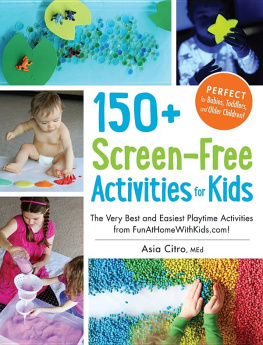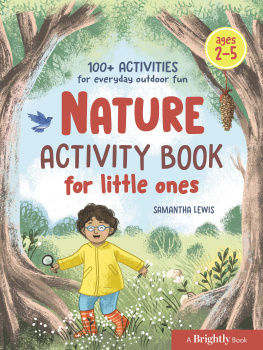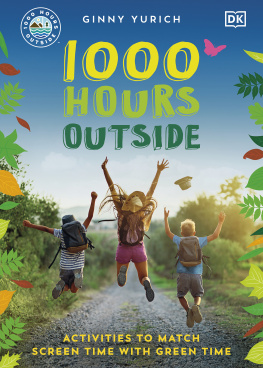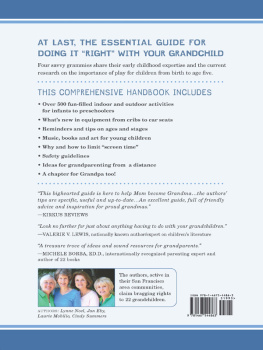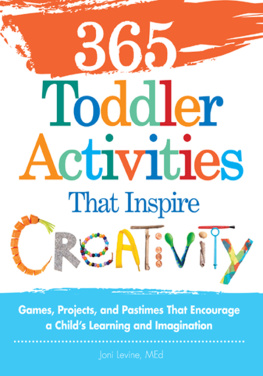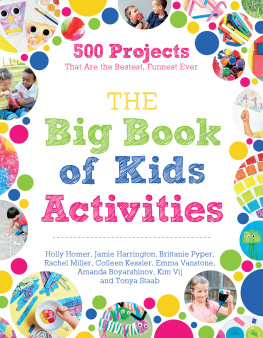150 Screen-Free Activities for Kids
The Very Best and Easiest Playtime Activities from FunAtHomeWithKids.com!
Asia Citro, MEd

Avon, Massachusetts
Dedication
To Goose and Bubba.
Contents
T-S Taste Safe G-F Gluten Free
Introduction
Play is often talked about as if it were a relief from serious learning. But for children play is serious learning. Play is really the work of childhood.
FRED ROGERS
Play is powerful. Through open-ended play, children learn to investigate and explore. They develop imagination and creativity. They learn to problem solve. In todays world, you are more likely to see a child poking at the screen of an iPad than poking a stick in a puddle of muddy waterand something important is lost there. Though educational games and TV shows have their merits, too much technology can be detrimental to a childs development. Children learn so much through activities that use their senses and move their bodies. Because technology does not involve the use of several senses and rarely involves full body movement, it limits learning. In most electronic games or shows, there is a specific path the writers want a child to follow and a set outcome for the story being told. A puddle of muddy water, however, provides an endless number of ways to play. It is a vast blank stage ready for a child to act out a story, create a work of art, or begin a scientific investigation. Whenever you are engaged in open-ended play you have a chance to discover something new and to play in a completely different way. Open-ended play plants the seeds of creativity. It fosters innovation and allows children to do what they do best: question, explore, and imagine.
If you are new to the idea of open-ended play, this book will provide plenty of guidance to get you started. If you are experienced, the book will expand the number of play recipes and activities at your disposal. Whether you are a parent, a grandparent, an educator, or a caregiver, this book has plenty of ideas applicable to any setting. The activities included here are the most popular, best loved, and easiest to prepare activities in my repertoire. You can move through the book in order or pick and choose the activities that appeal to you most. Each activity is laid out so that the simplest version is the one offered in the step-by-step directions. Its always great to start there, especially if it is a recipe/activity that is new to you. In the section following the simplest version of the recipe, youll find several ideas for variationsso within each recipe for a slime, dough, or simple sensory play, there are actually several activity ideas. As you explore with your children, they will develop favorites that can be repeated and varied time and time again.
There is no way to be a perfect parent. So just be a real one.
SUE ATKINS
I am by no means a perfect parent! Though we limit technology, its not as if my children have never seen TV or played on an iPad. Raising kids is hard and theres illness (theirs and yours), household tasks, and a multitude of other things that come up on any given day that need to be addressed. If you are a parent, you may work full-time and only be able to set up activities on the weekends. Its not necessary to spend every waking hour of every day engaged in open-ended play. In our family, some days we do play all day, but other days are lost to more mundane tasks. We do, however, focus on open-ended play and make it a priority in our house. I find that this is enough to foster creativity in our children.
Im often asked by parents what advice can I give them to help get kids interested in science? And I have only one bit of advice. Get out of their way. Kids are born curious. Period. I dont care about your economic background. I dont care what town youre born in, what city, what country.... So you get out of their way. And you know what you do? You put things in their midst that help them explore. Help em explore.
NEIL DEGRASSE TYSON
The arts often first come to mind when creativity is mentioned. However, it is a trait that is vital to nearly every profession and field of study. My husband has a PhD in mathematicsa degree that required creative problem solving. I have my undergraduate degree in biology and chemistry; the very basis of science is asking questions and working inventively to answer them. After completing my masters in education, I became a middle and high school science teacher. When we had our first child, I decided to stay home full time with our daughter. I started creating activities for her when she was 10 months old; there was something I wanted to offer her beyond what the typical toys from a store could provide. As she grew and I could see her creativity and imagination blossom as a result of our activities, I became even more invested in open-ended play. When her brother was born three years later, I focused on creating activities that would engage children of multiple ages at once. Around that time my friends talked me into starting a blog to share our various activities. I started Fun at Home with Kids in February of 2013, and it has grown more rapidly than I could ever have imagined! Fundamental to both the blog and this book is my belief in play for everyone; to that end, I have developed many safe recipes for playtaste-safe and allergen-freeso that all children, even children with special needs or food allergies, are able to participate. Where applicable, you will find allergen-free codes under the headings for our play recipes. I have also carefully selected materials that are low cost and are often reusable, and have included tips for those of you on tight budgets at the beginning of each main chapter.
I hope that within the pages of this book you find countless hours of creative, active, and engaging entertainment for your entire family!
CHAPTER 1
How to Use This Book
HOW DO I GET STARTED?
If youve never tried anything like the activities in this book with your kids, the hardest part is getting started. I know activity books can seem overwhelmingthere are so many choices and perhaps you dont have all the materials yet. So my challenge to you is to just try one thing. Everyone has water, so go check out Activities, and take a look at my water play activities. If you have a baby who is sitting up, you might want to set up my Baby Water Play; if you have an older child, you may want to set up the Water Transfer Challenge; if you have multiple children, you may want to try Colored Water Play. Just choose one and give it a go. Right now, if you can!
Once youve got that under your belt, I recommend. But for now, lets get you started gradually.
- Cornstarch
- Shaving cream
- Flour
- Cotton balls
- Cornmeal
- Vegetable oil
- Food coloring or liquid watercolors*
- Craft foam sheets in multiple colors*
- Dish soap
- Baking soda
- Vinegar
- Salt
- Gelatin
- Rice
- Contact paper
After securing these supplies, I recommend mapping out the week. Pick a day (a Saturday or Sunday usually works well) and sit down and plan out one activity for each day of that week. Just make a note somewhere of what you plan to do. Then each day move through a new activity. As you make your way through the book and activities here, you and your children will develop favorites and you will find that you need to plan less and less, as they will just ask for the specific activities they have in mind. If you take it one step at a time, it will all become very easy. But for now, the most important thing is to take that first stepso go grab some water!

